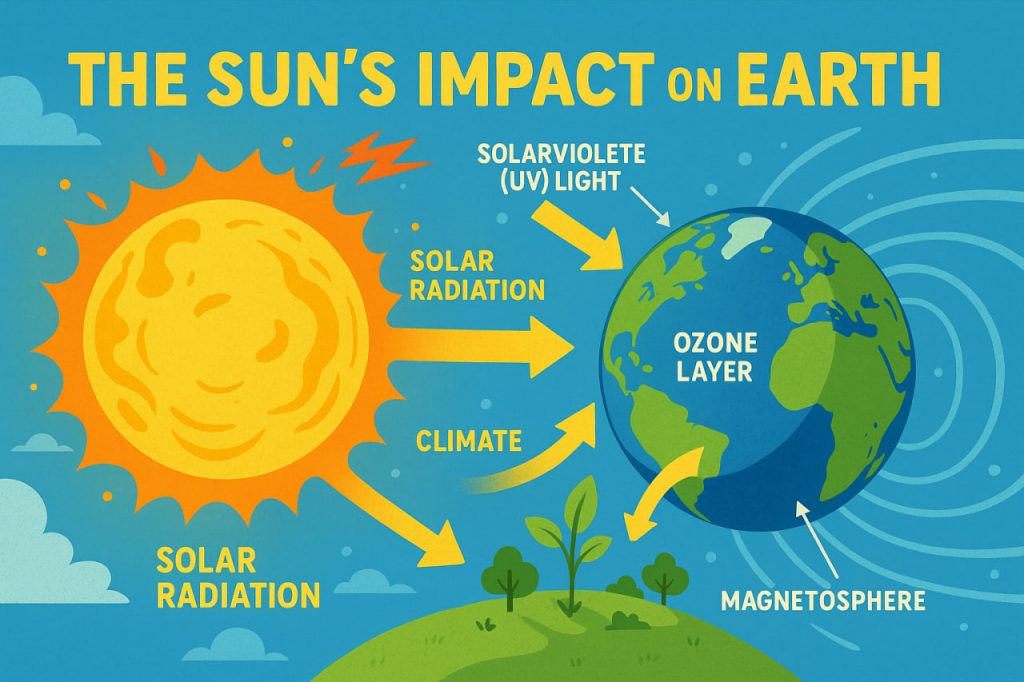The Sun is the central driver of nearly all natural processes on Earth. As the closest star to our planet, it provides the energy necessary for life, powers the weather and climate systems, and influences Earth’s magnetic field and atmosphere. However, the Sun is not just a steady source of light—its dynamic behavior can also pose risks to satellites, communication systems, and even human health.
Understanding the many ways the Sun affects Earth is critical for climate science, space weather forecasting, and protecting modern infrastructure.
Solar Radiation: Life’s Energy Source
The most vital effect of the Sun is its solar radiation—a mix of visible light, ultraviolet (UV) rays, and infrared heat. Solar energy drives photosynthesis, the process that allows plants to convert sunlight into chemical energy, which fuels the entire food chain. It also heats the Earth’s surface, creating temperature differences that drive wind patterns, ocean currents, and weather systems.
Without solar radiation, Earth would be a frozen, lifeless rock.
The Sun and Earth’s Climate
Solar output is not perfectly constant. The Sun goes through an 11-year solar cycle, during which the number of sunspots and solar activity rise and fall. These cycles slightly influence Earth’s climate. Some periods of low solar activity, like the Maunder Minimum in the 17th century, have been linked to regional cooling events such as the Little Ice Age in Europe.
However, modern climate change is primarily driven by human activity, not variations in solar energy.
Ultraviolet Light and the Ozone Layer
The Sun emits ultraviolet (UV) radiation, which can be harmful in large amounts. Earth’s ozone layer, located in the stratosphere, absorbs much of this radiation, protecting living organisms from DNA damage and skin cancer.
Ozone depletion in the late 20th century, caused by human-made chemicals like CFCs, led to increased UV exposure, but global efforts like the Montreal Protocol have helped restore ozone levels.
Space Weather: Solar Storms and Their Effects
The Sun releases high-energy particles and magnetic fields during solar flares and coronal mass ejections (CMEs). These can cause geomagnetic storms on Earth when they interact with our magnetosphere.
Effects of space weather include:
- Auroras near the poles (northern and southern lights)
- Disruption of satellites and GPS signals
- Power grid failures (as occurred in Canada in 1989)
- Radiation exposure risks for astronauts and high-altitude flights
Space agencies monitor solar activity constantly to provide early warnings of solar storms.
Sunlight and Human Health
Moderate sunlight exposure helps the human body produce vitamin D, which is vital for bone health and immune function. However, too much exposure can cause:
- Sunburn
- Skin aging
- Skin cancer due to UV radiation
Protective measures like sunscreen, clothing, and shade are essential, especially during peak sunlight hours.
Glossary
- Solar radiation – energy emitted by the Sun as light and heat
- Photosynthesis – the process by which plants convert sunlight into energy
- Solar cycle – a repeating 11-year pattern of solar activity
- Ultraviolet (UV) light – high-energy radiation from the Sun
- Ozone layer – a layer of gas in the upper atmosphere that blocks UV rays
- Coronal mass ejection (CME) – a large burst of solar plasma and magnetic field
- Magnetosphere – the region around Earth controlled by its magnetic field


